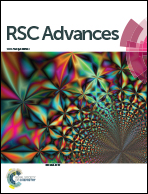Central C–C bonding increases optical and chemical stability of NIR fluorophores†
Abstract
Functional near-infrared (NIR) fluorophores have played a major role in the recent advances in bioimaging. However, the optical and physicochemical stabilities of NIR fluorophores in the biological and physiological environment are still a challenge. Especially, the ether linkage on the meso carbon of heptamethine core is fragile when exposed to serum proteins or other amine-rich biomolecules. To solve such a structural limitation, a rigid carbon–carbon bond was installed onto the framework of ether-linked NIR fluorophores through Suzuki coupling. The robust fluorophores replaced as ZW800-1C and ZW800-3C displayed enhanced optical and chemical stability in various solvents and a 100% warm serum environment (>99%, 24 h). The biodistribution and clearance of C–C coupled ZW800 compounds were almost identical to the previously developed oxygen-substituted ZW800 compounds. When conjugated with a small molecule ligand, ZW800-1C maintained the identical stable form in warm serum (>98%, 24 h), while ZW800-1A hydrolyzed quickly after 4 h incubation (34%, 24 h).


 Please wait while we load your content...
Please wait while we load your content...